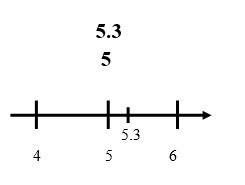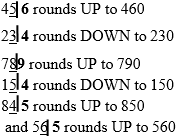Estimation
Learning outcome: After completing this module students should know how to round up and down and to estimate approximate values without making the detailed calculations.
3.1 Introduction
Numbers are rounded when accuracy is not needed or impossible. Rounding a number to a specific digit means replacing it with a number that is close in value but ends with zeros. Natural numbers are rounded to tens, hundreds, thousands, etc. If the number is rounded to tens, then we replace with zeros the digit in the category of ones. If the number is rounded to hundreds, then the digit zero should be both in the category of ones, and in the category of tens. The number obtained by rounding is called the estimated value of this number. The result of rounding should be written after a special sign “≈”. This sign reads “approximately equal”
When rounding a natural number, you may use the following steps:
- First of all, underline the digit of the group (ones, tens, thousands etc.) to which you need to round the number;
- Next, separate all the numbers to the right of this group with a vertical bar;
- If the digit to the right from the underlined digit is 0, 1, 2, 3 or 4 then all digits that are separated to the right are replaced by zeros. The digit of the group is left unchanged;
- However, if the digit to the right from the underlined digit is 5, 6, 7, 8, or 9, then all digits that are separated on the right by the bar are replaced by zeros, and 1 is added to the digit that is underlined.

As we see number 9 follows the underlined digit, thus we add 1 to the digit of thousands (it is 6), and we replace all the numbers separated by a vertical bar with zeros.
The answer is:
≈ 57,000
More examples with smaller numbers, if you wanted to round to the nearest whole number here, you would look at the digit right after the decimal comma since that is the digit to the right of the digit you want to round.
5,3
3,7
10,9
6,5
Let’s start rounding:
5,3 becomes ≈ 5
3,7 becomes ≈ 4
10,9 becomes ≈ 11
What about the 6,5? It‘s right in the middle. For estimating purposes, whenever you see a 5, you will round up.
When you round down, you round down to the nearest number. When it came to rounding 5,3 it should be rounded down to 5 because that is the closest one. We can draw it on the number line like this, so you could visually see that 5 is the closest whole number to 5,3.

3.2 Estimating to Different Places
You can estimate to whatever place you want. Let’s say you wanted to estimate to the nearest tens place. This means instead of estimating to the nearest whole number, you estimate to the digit that is in the tens place or the second one to the left of the decimal.
- To approximate to the nearest ten, look at the digit in the tens group.
- To approximate to the nearest hundred, look at the digit in the hundreds group.
- For the nearest thousand, look at the digit in the thousands group.
To estimate this digit, you would look at the digit in the ones place because that is the digit to the right of the digit you want to estimate.

Estimating these numbers to the group of tens, you would follow the same general rule as before, when we were rounding with decimals.
For example:

What do we need to do if we wanted to estimate to the hundreds place? Which digit to look at?



